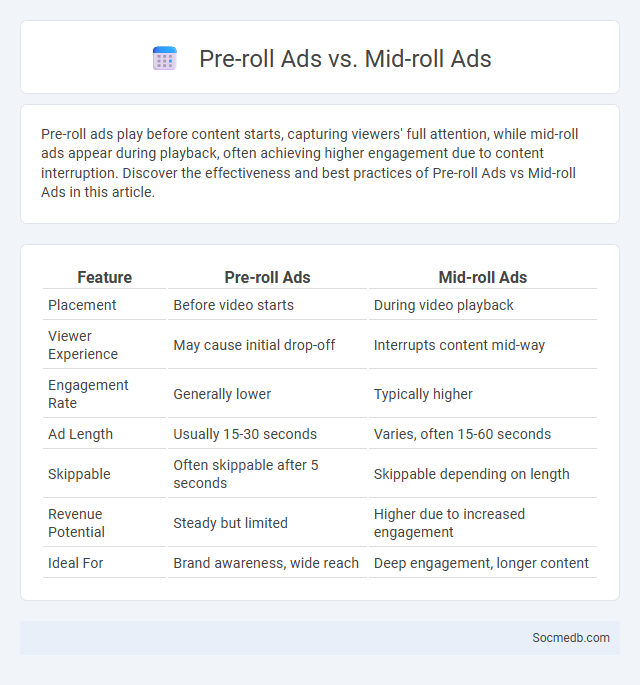
Photo illustration: Pre-roll Ads vs Mid-roll Ads
Pre-roll ads play before content starts, capturing viewers' full attention, while mid-roll ads appear during playback, often achieving higher engagement due to content interruption. Discover the effectiveness and best practices of Pre-roll Ads vs Mid-roll Ads in this article.
Table of Comparison
| Feature | Pre-roll Ads | Mid-roll Ads |
|---|---|---|
| Placement | Before video starts | During video playback |
| Viewer Experience | May cause initial drop-off | Interrupts content mid-way |
| Engagement Rate | Generally lower | Typically higher |
| Ad Length | Usually 15-30 seconds | Varies, often 15-60 seconds |
| Skippable | Often skippable after 5 seconds | Skippable depending on length |
| Revenue Potential | Steady but limited | Higher due to increased engagement |
| Ideal For | Brand awareness, wide reach | Deep engagement, longer content |
Introduction to Video Ad Formats
Video ad formats on social media include in-feed video ads, stories, and vertical video ads designed for mobile consumption. These formats leverage short, engaging content to capture user attention and drive higher engagement rates compared to static ads. Platforms like Facebook, Instagram, TikTok, and YouTube offer various video ad options optimized for targeting specific audiences and maximizing ad performance.
What Are Pre-roll Ads?
Pre-roll ads are short video advertisements that play before the main content on platforms like YouTube, Facebook, and Instagram. These ads typically last between 5 to 30 seconds and aim to capture viewer attention with concise, impactful messaging. Advertisers leverage pre-roll ads to increase brand awareness and drive engagement by targeting specific audiences based on demographics and user behavior analytics.
What Are Mid-roll Ads?
Mid-roll ads are video advertisements inserted in the middle of digital content, typically during longer videos or live streams on social media platforms like YouTube, Facebook, and Instagram. These ads enhance user engagement by appearing at natural breaks, increasing ad viewability and effectiveness compared to pre-roll or post-roll ads. Understanding how mid-roll ads work can help you optimize your social media marketing strategy to maximize reach and revenue.
Key Differences: Pre-roll vs Mid-roll Ads
Pre-roll ads play before your chosen video content begins, capturing attention with high visibility but often facing higher skip rates; mid-roll ads appear during natural breaks, offering better engagement due to interruption but risk frustrating viewers. Your choice depends on balancing user experience with marketing goals, as pre-roll drives immediate awareness while mid-roll can enhance message retention. Platform algorithms also affect ad performance, highlighting the importance of targeting and frequency control in social media advertising strategies.
Viewer Engagement: Pre-roll vs Mid-roll
Viewer engagement on social media is significantly influenced by the placement of video ads, with mid-roll ads generally yielding higher retention rates compared to pre-roll ads. Mid-roll ads interrupt content at a natural breakpoint, capturing an audience already invested, thus increasing click-through and interaction rates by up to 25%. Analyzing data from platforms like YouTube and Facebook reveals mid-roll formats lead to longer view durations and higher ad recall, optimizing overall campaign effectiveness.
Impact of Ad Placement on User Experience
Ad placement on social media platforms significantly influences user experience by balancing advertisement visibility and content engagement. Strategic ad positioning enhances click-through rates while minimizing disruption, leading to improved user satisfaction and platform retention. Poorly integrated ads can cause user frustration, decreasing time spent on the platform and negatively affecting overall engagement metrics.
Ad Revenue Potential: Pre-roll vs Mid-roll
Pre-roll ads generate higher visibility by appearing before video content, capturing viewer attention at 90-100% completion rates, while mid-roll ads benefit from longer engagement times due to their placement within content. Social media platforms report average CPM (cost per mille) rates of $15-$30 for pre-roll ads compared to $10-$25 for mid-roll ads, reflecting advertisers' willingness to pay premiums for assured ad views. Data shows mid-roll ads yield increased viewer interaction and retention, driving better conversion rates despite slightly lower immediate exposure.
Best Practices for Maximizing Ad Revenue
Maximizing ad revenue on social media requires targeting your audience with precision using data-driven insights and leveraging high-engagement content formats like video and interactive posts. Your campaign should employ A/B testing to refine ad creatives and adjust bidding strategies for optimal cost-efficiency. Integrating a multi-platform approach helps capture diverse demographics and increases overall ROI.
Choosing the Right Ad Format for Your Content
Selecting the right ad format for your content on social media platforms significantly enhances engagement and drives conversions. Consider native ads for seamless integration, video ads to capture attention quickly, and carousel ads to showcase multiple products or features effectively. Tailoring the ad format to your audience's preferences ensures your message resonates and maximizes your campaign's impact.
Conclusion: Optimizing Video Monetization
Optimizing video monetization on social media requires a strategic approach that leverages audience insights, platform analytics, and content relevance to maximize revenue potential. You should focus on creating engaging, high-quality videos tailored to your target demographic while utilizing multiple monetization tools such as ads, sponsorships, and subscriptions. Consistently analyzing performance metrics and adapting your strategy ensures sustained growth and increased earnings from your social media video content.
 socmedb.com
socmedb.com